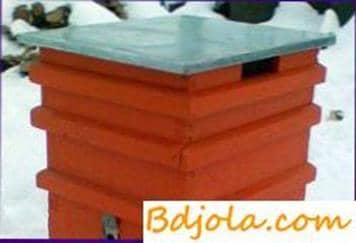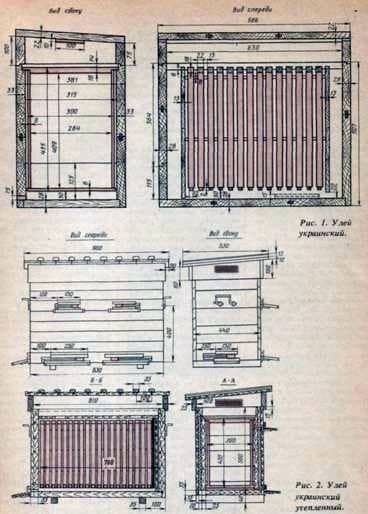
First a bit of history. With the introduction of PI Prokopovich (1814), and then L. Langstroth (1851) and L. Berleps (1852) into the practice of apiculture in beekeeping, the efforts of researchers and beekeepers-practitioners were aimed at finding and justifying the most optimal size of the framework and the corresponding Types of hives providing the highest productivity of bee colonies.
The opinions of the beekeepers were divided. L. Langstroth, Sh. Dadan, A. Ruth and their followers followed the path of introducing low-width frames, that is, those whose frame height is less than or equal to its width. They believed that in this case the greatest strength of the combs is provided, a compact socket is created. Other beekeepers preferred narrow narrow frames, in which the height is greater than the width. The idea of creating such a framework, they borrowed from bees, inhabited in hollows, decks and shelves.
One of the most consistent supporters of the narrow framework was the Polish beekeeper Kazimir Levitsky. Measuring the size of honeycombs in the sides, K. Levitsky came to the conclusion that the width of the frame should be 240, and the height – 432 mm. The hives developed by him were widely used in Poland and Ukraine. The popularity of the hive Levitsky was facilitated by the simplicity of working with him. We did not need any second hulls or extensions. This was important for farmers who did not have sufficient knowledge about the life of bees. Serving families in these hives also did not require a lot of time.
When assembling the nests for the winter in the hive Levitsky, it was enough to leave six or seven honeycombs filled in the upper part with honey, and success is assured. Bees form a club whose diameter roughly corresponds to the width of the frame. Rising in winter to the ceiling, the club has the opportunity to fully utilize the food reserves. To leave him from the fodder, as in other hives, it is simply impossible. A narrow and long nest warms the bees well, contributes to the intensive development of the family in the early spring period.
The huge variety of hives that developed at the beginning of the 20th century began to really restrain production and sharply raised the question of their standardization and unification. A passionate champion of the standardization of the framework and hives in Russia was the teacher Boyar school of beekeeping in the Kiev province V. Yu. Shimanovsky. He managed to persuade the congress of beekeepers, held in January 1918 in Kiev, to accept the uniform size of the framework for the whole country and recommend the main types of hives for them. The decisions of the congress were approved in 1921 by a special commission of representatives from the central institutions attached to the Kyiv Gubernia Department. The dimensions of the beehive frames set by the congress are 435X300 mm; 435X230 mm; 435X 145 mm are strictly observed and up to the present time.
As an alternative to the frame of K. Levitsky (240×432 mm), the congress after long discussions took the “reverse” frame of Dadan (300X435 mm), calling it, on the proposal of I. I. Korablev, Ukrainian and the hive for it – Ukrainian.
The first description of the Ukrainian hive was made by V. Yu. Shimanovsky in the journal “Beekeeping Business” No. 1, 1923 and in more detail – in his book “The First Steps to the Device of the Apiary” (1927).
According to V. Yu. Shimanovsky, this Ukrainian beehive consists of a hull, a roof, two diaphragms, 16 nest frames and an integral bottom. The length of the case is 686 mm, width – 381 and height – 507 mm. The thickness of the front and back walls 33, the lateral and bottom – 28 mm. Walls and the bottom are collected from separate plots, united in a rail on glue. At the corners of the wall are connected in a quarter.

In the right wall of the case at the bottom is made an outlet 115 mm high, closed with a special lid (bushing). On top of the outer edge of the body, a seam 6 and 16 mm wide is selected for the installation of the roof ridge, and on the inner edge of the front and rear walls, a fold 8 and a depth of 22 mm for the frame shoulders.
In the front wall, a chamfer height of 15 and a width of 160-200 mm is cut. It is displaced to the left of the center, it is closed by a grid, reclining downwards and serving simultaneously a landing board. Depending on the applied method of bee-keeping, another one or two tap can be made in the hive.
The roof of the hive is one-run, attached by loops at its high side to the front wall of the hive. The roof consists of a harness and a shield. The walls of the strap are connected to each other in a quarter. Thickness of longitudinal walls 33, lateral walls – 28 mm. The shield is assembled from boards 22 mm thick, cohesive in a rail. In the side walls of the piping, ventilating windows with a height of 15 and a width of 100 mm are cut, barred from the inside by a grid. On top, the flap is covered with a roofing tin with curved edges.
Ukrainian hive is completed with 16 frames (300X435 mm) without permanent dividers. The top bar is 330X22X8 mm in size, the bottom is 312X12X8 mm and the two side strips are 419X22X8 mm. The dimensions of the hinged frames are 115 mm. The lower bar is nailed to the end of the side panels and protrudes on the sides by 6 mm, forming wall dividers.
Diaphragms serve to limit the nest, and, if necessary, to divide the two families. Each diaphragm provides a shield, riveted from individual plates with a thickness of 13-20 mm. It is suspended in a hive with the help of an upper block on the quarters of the hull. To the walls of the hive, the diaphragm is closely adjacent, and from the bottom is 10 mm. When transporting bees, the side sleeve is replaced by a frame with a grid through which ventilation is carried out.
In the literature, you can find descriptions of Ukrainian hives, somewhat different from the one given. Currently, in accordance with the republican technical conditions, a hive on the Ukrainian frame is produced in Ukraine with insulated front and rear walls and an integral bottom.
It is designed for 20 nest frames (435X300 mm). The side walls and bottom have a thickness of 35 mm. Front and back – double internal walls are made of boards with thickness 25, external – 15 mm. The interstice space is filled with a warming material – straw, shavings, etc. In the front wall are equipped with two lower and two upper flanges. To the left in the side wall is the lower chute to the warm drift. The height of the tapholes is 12 mm.
In conclusion, I would like to make a few critical remarks about this hive.
Another K. Levitsky noted that education during bribe in the upper part of the nest elevated temperature and humidity forces the uterus to abundant oviposition, and the bees impel to swarming.
Further, the elongated honeycombs are undoubtedly less durable and worse attached to the bars.
The rims from inside the ventilation windows in the roof trim and the barbed sleeve during transportation are blocked by bees.
Влияние меда на печень мед. Определение падевого меда.
Hives, inventory